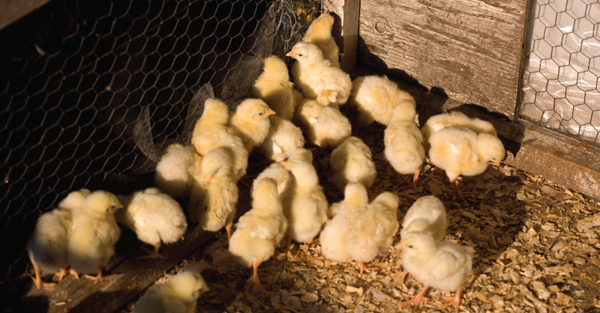
“The best guide in all these things is nature, and an observer will always find that poultry choose a sheltered spot. They also carefully avoid being exposed to cold winds.”
–SIMON SAUNDERS, in Domestic Poultry being a Practical Treatise on the Preferable Breeds of Farm-Yard Poultry, 1868
3
Housing Chickens
The chicks have come a day early. I’m usually only half prepared for their arrival by mail anyway, always busy trying to find the three-prong adapter for the extension cord or marbles to stick in the water tray so the chicks won’t drown. Today is even more complicated, because I don’t have the day off, and I have an early-morning meeting to make. To make things worse, I have the flu, and don’t feel like doing anything at all.
Typically, when Gloria from the post office makes the 6 AM call to the farm, I’ll rush down to collect the boxes of babies, then spend the whole morning checking their feed, their heat lamp, and their water in the brooder box.
Instead, today I hastily prepare the box, install the heat lamp, fill the waterer, and sprinkle chick starter mash on the newspaper floor. The box is only a temporary house. It acts as an intermediary between their shipping box and the pen where they will spend the first few weeks of life. From this pen, they’re moved to an outside coop, where they’ll forage for insects and eat vegetation in addition to the grain. I leave the chicks to attend my meeting.
The brooder box has a finicky light switch. If a hen decides to roost on the outside of the box and hits the cord just right, it snaps off the heat lamp inside, leaving the chicks in total darkness and cold. Usually the light will snap back on after the chicken has jumped off the box, and the chicks will resume scurrying across the newspaper, picking up grain, and chasing each other.
But when I return to check on the box three hours later, there is chaos inside. The heat lamp is out, and at first I really can’t tell what I’m looking at. The little fluffy bodies are now soaking wet, and they are lying still, stretched out in unnatural positions on the soggy newspaper. Apparently all 50 white chicks have drowned in the waterer, piling one on top of another, after the heat lamp had gone out. Why they have decided to commit mass suicide in the waterer is beyond me.
The sheer waste of life that I could have prevented overwhelms me. I sit by the box and start to cry. Sobbing so hard in fact, that the little black-and-white barn cat, which rarely shows his face, crawls over to me and swishes his tail, back and forth, puzzled at what I am doing. I stop the tears to pick him up and stare at the chicks again. Then I notice that some of them are moving, their bodies twitching and fighting for life.
I jump up, spilling the cat to the ground, and scoop the moving chicks into my tee shirt. I run to the house, grab a baking dish, and pop them in it. Then I set the gas oven to 110 degrees Fahrenheit and stick them in. Within minutes, I hear the happy sound of warmed chicks, in search of food. I keep thinking to myself that it’s time to change that fixture on the brooder box as I cheerfully scoop up the chicks that are “done” back out of the baking dish. This time, I was lucky.

Cornish Rock cross meat bird chicks warm themselves in the early morning.
When we began raising meat chickens, they lived for the first few weeks in the room we grandly call the library, next to the computer. After the ventilation fan failed in the motherboard, we began raising them in the unfinished bathroom. Their dander and the grain dust turned the ceiling brown, so that when anyone ran the hot water in the sink, condensation would form on it and brown drops slowly fell to the floor. From that day forward, we decided that chicks should be raised where furniture and equipment could be spared—in a chicken house.
Newly hatched chicks need a draft-free area that is warm and dry. This can be as simple as a cardboard box lined with newspaper and a bare lightbulb for heat, or as fancy as an entire area of your coop dedicated to new chicks.
What you are attempting to duplicate are conditions that the mother hen would supply to her chicks. Normally, the hen will cover her chicks, or “brood” them, providing shelter and warmth. She listens for cues to determine when they are hungry, and then she will unceremoniously rise and lead them to food and water when necessary.

Doing what a mother hen would usually do, the author introduces newly delivered chicks to water in a brooding box. Stones in the water dish prevent them from falling into the dish and drowning.
In their artificial environment, chicks should have enough space to be warm but not overheated. Overcrowding can create sanitation problems, suffocation, and even cannibalism. Ideally, the pen that chicks are started in should have rounded sides, so that there are no corners for chicks to pile up in. From day one to three to four weeks old, each chick will need about half a square foot of space. From age four weeks to 12 weeks, the amount of space required for each will increase by a square foot every month. Full-grown chickens need about 3 square feet each.
The temperature in your new chicks’ pen should be about 95 degrees Fahrenheit for the first week of life. Heat lamps with 250-watt brooder bulbs placed at least 17 inches from the bottom of the pen will adequately warm a 12-square-foot area in an 8-foot by 4-foot by 3-foot-high pen, provided that it is draft free. A 100-watt bulb in a cardboard box will provide heat just as well if you are raising the chicks in your kitchen for the first week of their life. Put a thermometer on the bottom of the pen below the bulb and check that it registers 95 degrees. Any hotter, and you run the risk of the bedding catching fire; brooder lamps are fitted with reflectors and a wire guard so that if they do fall, there is less chance of paper or chicks becoming burned. The temperature within the brooder can be decreased by 5 degrees every week until it reaches 70 degrees. At this point, the chicks will be about three weeks old and capable of maintaining their body temperatures adequately, provided they still have adequate shelter from cold, wet, or extremely hot conditions.
Observe your chicks in their new environment. Contented chicks will emit soft cooing calls, not shrill panicked sounds. They will be scurrying about the pen, searching for food and drinking occasionally. If they’re all huddled under the heat source, they’re most likely too cold. If they are hugging the sides of the pen, avoiding the heat lamp, they are probably too warm.
At Fat Rooster Farm, we use this succession of pens before the chickens are turned loose on pasture:
DAY ONE TO DAY FOUR OR FIVE. Chicks are removed from their shipping boxes to a plywood brooder that measures 2 ½ feet wide, 21 inches high, and 3 ½ feet long. The bottom of the box is mesh hardware wire, lined with newspaper (the non-glossy type). The waterer is put at the far end of the box, away from a heat lamp that hangs about 17 inches from the bottom of the pen. The heat lamp is a red-tinted 250-watt bulb in a porcelain fixture. The chicks are provided with light 24 hours a day to encourage them to eat and keep them from panicking and suffocating if they pile on top of one another for warmth. The top of the pen is hinged, and propped open for ventilation. Pebbles or marbles are placed in the water tray to discourage the new chicks from piling into it and drowning. Grain is sprinkled on the newspaper for the chicks during these first few days. Each of the chicks has its beak dipped into the waterer to ensure that it knows where to drink—remember, the mother hen would cluck and call her chicks to food and water. She would drink and pick up grain to show them what to eat. While chicks can instinctively feed and drink, teaching them how to do these tasks will decrease their chances of becoming weak and dying after their stressful journey to their new home.
DAY FIVE OR SIX TO THREE WEEKS OF AGE. The chicks are moved to a “chicken tractor.” It’s referred to as a tractor, because it’s a pen that is four-sided, with a hinged top, but with the base of the pen being entirely open. This allows the chickens to scratch up and till the soil, like a tractor would, fertilizing and cultivating it in one fell swoop.
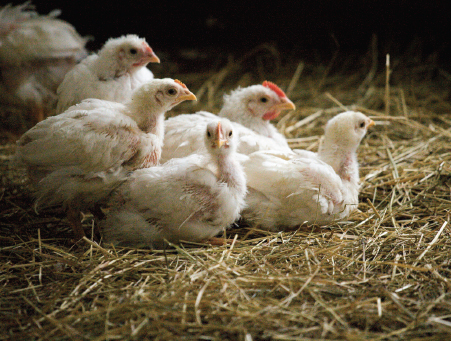
Cornish Rock cross meat birds huddle together in the barn at Fat Rooster Farm. Due to customer demand, the farm raises batches of 100 to 150 meat birds every six weeks through the summer.
Hens peck at grain left behind after a chicken tractor was moved. The ten-year-old coop requires two people to move it–later versions on the farm are lighter for one person to move.
There are several versions of tractors available; the one that we have settled on is lightweight and easy to construct. Our pens, made from two-by-fours that have been ripped down the middle, measure approximately 8 feet by 4 feet by 28 inches high and have a total area of approximately 32 square feet. Each side and the top is constructed separately and is held together with carriage bolts so that the pens can be dismantled at the end of the season and stored flat against a wall. The corners of each of the panels are braced with wood, and the sides and tops are covered in 1-inch chicken wire. The top is covered with waterproof material like a plastic tarp, and three of the pen’s sides are covered with plastic or tarps. The tractors are set up in a sheltered structure (in our case a converted dairy barn) where the temperatures don’t fluctuate wildly between night and day, and where wind and rain are not a threat. The pens are four-sided with a hinged top, completely open on the bottom, and the floor of the barn is spread with pine shavings. Don’t use cedar shavings—they can irritate the chicks’ eyes. Using hay can create obstacles for the chicks as they attempt to walk around, and it is not very absorbent or easy to clean up afterwards.
For every 50 chicks there is a 1-gallon waterer placed within 2 feet of the heat source. Grain is put in trough feeders placed within 2 feet of the heat source. During the first two weeks, there is a 250-watt heat lamp in either corner of the pen.

Moving Chicks Outside
Transitioning chicks from a pen that has been heated artificially, kept from wind, rain, and sun, and kept free of predators to pasture can be difficult. Before the move is made, you should:
• Wait until the chicks have developed their scapular feathers, the little band of feathers above their wings on their backs. The feathers look a little like the shoulder pads on football players. They act to insulate the chicks from sun, cold, or wet conditions. Typically, chicks develop these feathers at about three weeks of age. Chicks should not be moved outside if nighttime temperatures within the pen can’t be regulated above 60 degrees Fahrenheit, otherwise, they’ll spend most of their energy keeping warm rather than growing.
• Wait until weather patterns are stable for your move. Choose a day to transition the chicks when the next few days don’t threaten steady rain, thunderstorms, heavy winds, or intense heat.
• Move the chicks well before sunset so they can grow accustomed to their new surroundings. Put familiar watering and feeding devices in their pens to encourage them to eat and drink immediately.
• Have at least three sides of their new pen enclosed, and provide a heat light on a timer for the first few days to provide them with heat and light at dusk through dawn. Red-colored bulbs will disrupt their sleep patterns the least and may attract fewer predators than the white bulbs. At night, the pens should be predator proof, either closed tightly, or surrounded by electrified poultry fence (Appendix Four).
• Monitor the chicks closely through the first few hours in their new home. They should be scattered about, busy foraging, emitting few, if any distress sounds (high-pitched, constant peeping sounds instead of pleasant, cheerful notes of content).
• Don’t mix different batches of chicks together at the time of the move. This can lead to bullying or distraction from eating and drinking.
Buff Silver meat birds huddle together in a chicken tractor—a portable coop. The coop allows for the birds to be on fresh grass and distributes their manure.
• Make sure that feeding and watering stations are sheltered so that the young birds are not forced out in downpours or extreme heat to forage. These can either be areas inside an enclosed pen that are covered, or individual range shelters that act to keep feeding stations dry. Changing the location of feeding and watering stations will also distribute areas littered with grain and wet ground. The birds will tend to defecate more near where they are fed and watered, so manure will be more widely distributed if the stations are moved daily.
• As the birds mature, your management of feeding areas and shelter will change. When the birds are small, their feeding stations may need to be changed less frequently. As they mature, you may find yourself moving feeding stations and pens every day where they seek out shelter during inclement weather and at night. You may need to rotate the electrified boundary fences to change out their yards. At Fat Rooster Farm, we start out each new batch of chicks that is introduced to pasture by providing an enclosed shelter surrounded by electrified poultry fencing. As the birds grow accustomed to their outside quarters, we remove the fencing, allowing them to mix with the other birds. There is still predator protection along the perimeter of the common yard, and the night shelters continue to be moved so that a manure pack doesn’t build up where the birds roost during the night.
A Plymouth Rock cross cockerel meat bird rests on a log in the pasture.
Just because you have observed an animal that could potentially prey upon your birds does not mean that you should break out the AK-47 . . . yet. Eating livestock is a learned behavior for wildlife, and many individuals will never be attracted to the barnyard or connect your chickens with the dinner bell. If you go out and remove a potential predator when it is not really harming your birds, you also run the risk of another individual coming in to replace the one you’ve removed that does know how good free-range chicken tastes.
The type of predators that may harm your chickens will vary depending on your location. However, the big seven will most likely be: hawks, owls, foxes, coyotes, raccoons, skunks, and weasels. Snakes, domestic dogs, feral cats, rats and other rodents, and anything from a mongoose to a mountain lion could also be attracted to your chicken buffet. Determining what kind of predator you have can help you catch and kill, or at least deter further losses.
All birds of prey are federally protected, and purposely harming one in any way carries steep fines. Don’t set out to kill a hawk or owl unless you’re prepared to face the legal ramifications.
One winter, we had a barred owl who repeatedly found his way inside the chicken house and killed three of my favorite hens. We contacted the wildlife experts in the area, and they relocated the owl for us.
Chickens that have been killed by birds of prey are usually left behind rather than carried off. Often, they are headless, their breasts are plucked of feathers, and the meat as well as the innards have been consumed. If you examine the carcass closely, you may see talon marks where the bird has held it while dining. Other signs that a raptor is responsible for the losses are impressions of wing feathers in the snow or dust, or an occasional lost feather that is clearly not from your chickens.
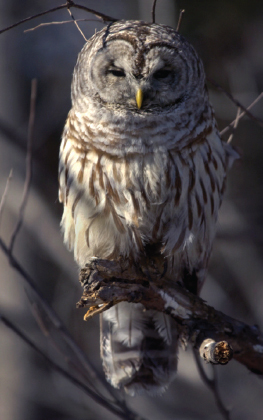
A barred owl roosts in a tree while visiting a village backyard in Wilder, Vermont. While they are a nuisance toward chickens, all birds of prey are federally protected and require contacting wildlife experts for assistance in relocating them.
Pastured poultry should be provided with overhead shelter of some sort, whether it is an enclosed box that is moved daily, bird netting over their foraging yard, or even a truck cap that they can duck into if a bird of prey appears. Most hawks will prey upon chickens during early morning or evening, so confining the chickens to a protected area at these times might prevent attracting hawks to the area. Owls, on the other hand, like to hunt after dark, so penning the chickens up will avoid losses. Setting your birds up near outbuildings and areas with human activity can also deter winged predators. Avoid pasturing the chickens near woodland edges or dead trees that can be used as perches from which hawks or owls can study potential prey.
Foxes and Coyotes
Foxes and coyotes are legally hunted during the year in most states. Check with your local wildlife officials for specific rules pertaining to your area. These animals can also be removed outside of hunting season in many states if you obtain a nuisance wildlife permit.
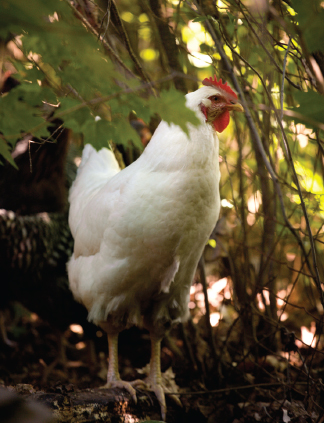
Whitey, a White Rock, wanders amongst the bushes at Carol Steingress’s and Rick Schluntz’s home. The couple have been keeping 5 to 6 laying hens in their small in-town yard for the past 10 years. “I think they’re so interesting and curious,” Steingress says. “We’re hooked.”

With its prey caught, a red fox looks to return to its den on a warm Spring morning in Strafford, Vermont.
Both foxes and coyotes can do a lot of damage in a short time. In fact, foxes will even kill and partially bury their prey in frenzy, attempting to stockpile as many as they can. Just as often, however, birds will just go missing, having been carried back to the den, with little or no trace. Both tend to hunt in the early morning or evening, although hungry individuals can prey upon your birds at any time if they are desperate enough.
Again, confining the birds at night and in the early morning will make them less attractive; some say that domestic dog hair scattered around the chicken yard or human urine is also a deterrent. Playing a radio near the coop may also help. One friend uses a guard dog in his chicken yard, much like a sheepherder would.
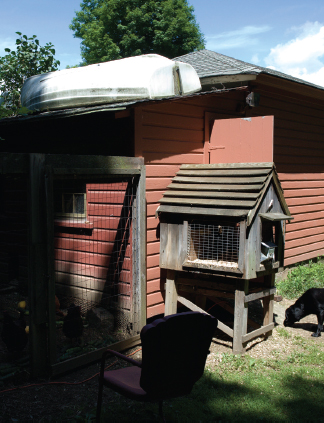
Willow, the family dog, explores the manure left behind by chickens outside the coop at Karl Hanson and Cloë Milek’s home. The coop used to be a shed attached to the back of the garage; Hanson proposed to Milek on Valentine’s Day when he left a ring for her in one of the chicken’s nesting boxes.
Raccoons can also be removed if they prove to be “nuisance wildlife.” Again, contact your local wildlife officials for specific laws protecting these animals before doing something that will get you in trouble later.
Raccoons are extremely crafty. They are capable of pulling staples, opening windows, unlatching doors, and practically serving up the chickens, which you are so desperately trying to protect, with a side of pasta and marinara sauce. They, too, can wipe out a flock of chickens in short order. We had one raccoon that would lure the chicks to the chicken wire so that it could reach in and deftly pluck them from the cage by their necks. Another stopped raiding the coop while the traps were set and resumed destruction the day they were removed.
Raccoons tend to kill and eat their prey at the scene of the crime. Usually, there are sharp punctures near the bird’s head, and the body will be ripped open and partially eaten.
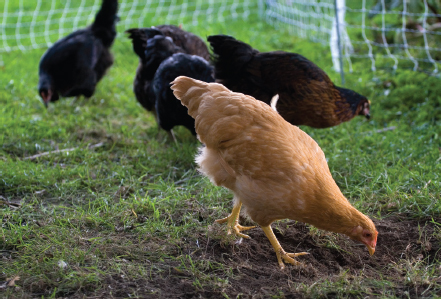
Goldie, a three-month-old Buff Orpington/Barred Rock cross pullet, forages in the backyard pen with her Black Sex-Link coopmates at the home of Geoff Hansen and Nicola Smith. Hansen decided to use an electric netted fence to keep the family’s two beagles a safe distance from the birds.
Predators
Last night, while I was patrolling the meat birds with the gun, the air was filled with fireflies. I know that we “self-sufficient” folk are supposed to eschew modern gadgets, like iPods and such, but I can’t describe the feeling of walking through the whirling flashes of lightning bugs, listening to Conor Oberst sing about his inability to hail a taxi in the city. His frustration with what seems so perfect in the evening turning to empty baggage in the morning was a fitting juxtaposition to my hectic day: fireflies making a light show for me by night, when everything had been put to bed, when all is quiet and magic and mist, waiting for that raccoon to show up, petting the barn cat milling around my feet, remembering how lucky I am to have this place.
The easiest way to catch a raccoon is to hide a live trap such as a Havahart near your birds. I use hay bales on either side and on the top of the cage that creates a tunnel into the trap. Salty bait like ham, mackerel, or leftover chicken work well as enticements into the trap.
Skunks can mimic a raccoon in their method of killing and eating chickens. Generally, though, their odor at the scene of the crime is a dead giveaway. They are also not as fast or as crafty at catching chickens, so you may find living birds with tiny puncture wounds near their heads or tails. Because it is harder for them to catch the chickens, they’ll usually devour one more fully, say, than a raccoon will, which might leave the intestines and other organs in its haste to find another victim. Skunks can be live-trapped, and provided that they are dealt with gingerly, there is little risk of being sprayed during their dispatch. They do tend to spray after being shot, though, so if you choose this method of capture, shoot upwind.
Weasels
By far, I am most afraid of weasels when it comes to predators of poultry. They are capable of killing an entire flock of 20 or 30 chickens in a night, and they are extremely hard to capture. Weasels tend to eat just the heads of their prey first, so if they are overcome with a feeding frenzy, you can expect to find many dead chickens with nothing but their heads missing. A bird of prey, on the other hand, will very rarely kill more than one or two birds at a time. Add to this the near impossibility of capturing a marauding weasel, and you’ll understand my fear.
Rosie, a Black Sex-Link hen, wanders back to the entry of a backyard coop. Designed by his friend Alex Cherington of Hartford, Vermont, Hansen and Cherington built the “Mini Coop” together over four nights and weekends.
Weasel-proofing a chicken house requires using fine mesh wire such as hardware cloth. Generally, they hunt at night, so confining your chickens to a “safe house” will deter these predators. In the past, I have opted to move the chickens’ outside locations to a different site rather than attempt to foil a weasel; if you have the space, that may be the easiest course of action to take. Using rat traps that have been tethered to the ground can also be effective.
Domestic Animals
Dogs and cats are also natural predators of chickens. Although their need to kill for food may be lacking, their predator instinct is often times still intact.
My clumsy, sweet, 3 year-old black Labrador retriever, Dart, will mock-chase his quarry. He’ll scatter the chickens, turkeys, and peacocks around our yard like leaves falling from a tree in an early Nor’easter. The problem arises when a companion joins in the fun, like my sister’s boxer, Edith. Then, a competition begins, and whoever can make the chickens more frantic becomes the victor, sometimes at the expense of the chicken.
When you make the decision to allow new dogs near your flock, be aware of the possibility of “pack mentality,” like Dart and Edith’s. Even if your acquaintance assures you that her dog is fine around birds, the game may change when a rival player enters the field.
Domestic dogs very rarely carry off what they’ve killed. Usually, birds are left in the yard or near the coop, badly maimed or injured. As a flock owner, you do have legal rights regarding the protection of your flock from domestically owned dogs. It’s always a good idea to get a town or city official involved in wading through this situation; confronting a neighbor after such a devastating event can be very emotionally charged and may not result in the best outcome.
Domestic cats can also pose a threat, particularly feral cats. They are responsible for millions of songbird and rodent deaths—including deer mice, shrews, voles, and grounds squirrels, not just the dreaded Norway rat. Back yard coops in urban areas are easy targets; to protect against the threat to your flock, a safe yard to roam and a secure roost at night is needed.

While house cats pose far less threat as predators to chickens, domestic dogs, foxes, raccoons, and skunks as well as weasels, minks, and birds of prey can wreak havoc on a flock. Having a chicken coop is somewhat akin to hanging up a "Free Chicken Dinner" sign, unless you protect your flock.
Chicken coop designs can be elaborate affairs, ranging from two story buildings several square feet in area to mini-coops that house enough chickens to supply a family with eggs. Our laying and breeding stock winters in a converted wing of the dairy barn that was used to raise the young cows (heifers). It has windows on three of the four sides, a cement floor, and doors on either end.
There are several websites that contain plans for coops, and most extension agents have floor plans for coops (see Appendix Three and Four). Regardless of which design you choose, there are several points to consider when you decide to build your coop:
• It should be easily entered to clean. Make sure the doors wide enough for a wheelbarrow and there no obstacles in the way. You don’t want anything to make you put off cleaning efforts, so make it easy to accomplish the task.
• The coop should not have extremes of temperature. It should be free of drafts and provide shelter from rain, wind, and extreme heat or cold and stay well ventilated.
• Ideally, electricity and plumbing should be close by so that feeding and watering is a simple task. In the winter, when daylight diminishes, it is very handy to have an outlet for an artificial light source that can be used to stimulate continued egg-laying.
• There should be roosts to encourage sleeping within the coop and nesting boxes to entice hens to lay their eggs indoors rather than in the flowerbeds or the hay pile.
• The coop should be large enough to house your birds comfortably; having a separate area for new arrivals to the flock, sick, injured, or breeding birds is also handy.
After Erin Regan lost her first flock of laying hens to a fox, she built a second-floor coop over her Bethel, Vermont, sheep barn. With its "free-range on-ramp," the coop’s door is opened with a rope on a pulley. Regan also plays a radio around-the-clock to keep the predators away.
Location
Make sure to locate your coop in an area where there is good drainage, adequate light, and good airflow for ventilation. A south-facing exposure will provide good light and solar gain during the colder months. Having the coop too high on a hill can expose the birds to excess winds in the winter and greater temperature extremes in the summer months. On the other hand, placing it in a hollow or depressed area will make it harder to access during wet periods and will create muddy, unsanitary conditions.
Cross-ventilation is important for good health, as it removes ammonia and excess moisture from the air (it also comes in handy when you need to clean the coop and don’t care to asphyxiate). If your coop includes a fenced-in yard, be sure to locate it away from snowmelt or flash-flood potential. Ideally, the yard should lean more toward sandy loam rather than clay so that precipitation quickly percolates into the ground. If you have heavy soil, you might consider bringing in sand to the yard area to facilitate good drainage.
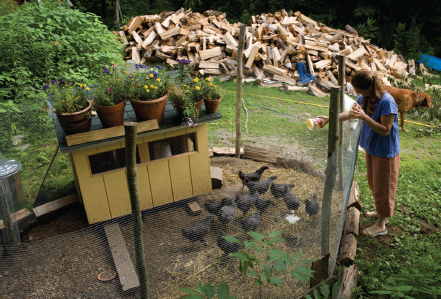
Jennifer Hauck gives her Plymouth Rock pullets a treat of spoiled yogurt in the pen outside the “Mini Coop” designed by her partner, Alex Cherington. Cherington believes the small design of the building will help the chickens stay warmer in the wintertime.
Design
The interior layout of your coop should provide roosting, feeding, and egg-laying areas (if you are keeping laying hens). Enough space for your flock to exercise and dust-bathe when it spends time inside the coop will prevent overcrowding that can lead to cannibalism. A general rule of thumb is 3 square feet per bird, but this can vary depending on how much time your birds will be allowed to spend free-ranging, the breed of bird you choose to raise (are they flighty or docile, heavybodied or bantams?), and your climate (how many inclement months during the year will the birds prefer to spend inside the coop?).
What materials you use to construct the coop will depend largely on the type of enterprise you choose. Obviously a concrete floor is not what you’d want for a portable coop, nor is it ideal for meat birds that you intend to free-range. Budget constraints could also determine construction design.
Windows provide light and ventilation, both of which are crucial for the health of your birds. The most practical windows should be able to open completely during hotter months when maximum air circulation is needed to keep your birds cool. They should also be able to close tightly during winter months to keep your birds warm. We usually cover the window glass with a layer of plastic during the coldest months to cut down on drafts.
Having ventilation holes at the top of your chicken house will serve as a means of ventilating the coop when the windows are shut tightly for the winter. The holes can be rectangular openings located along the roof’s eaves or circular holes located in a series along the top of the coop’s walls. Be sure to have a way to seal the ventilation holes up on the coldest nights.
Some poultry keepers build a sun porch on the south side of their chicken coop that provides them with a warm, comfortable space and enough light to keep them laying through most of the winter. The sides of the porch can be banked with plastic, leaves, or bales of hay to cut out drafts, and the entrance to the porch can be open and shut at night to reduce the area in the coop exposed to outside temperatures.

Farmer Ray Williams unhitches the tractor after moving the portable chicken coop at Back Beyond Farm. Williams and his wife, Liz York, switched to using a portable coop after the free-range chickens began to get into the greenhouses and were pecking at the tomatoes they raise to sell.
The chicken’s door to the outside should be separate from your access to the coop. The chicken’s door can be just over a foot high and wide, just big enough for them to come and go. This door can be hinged at the bottom and latched at the top so that it can be closed at night and during inclement weather. Your access to the coop should be larger. Remember to make it so that cleaning out the coop can be done easily. If you have different rooms in your coop, like we do at Fat Rooster, there should be chicken and human entryways to each. Old storm doors work very well in chicken coops. They also have the advantage of being able to be fitted with a screen during warm weather for added air circulation.
Floor
Cement floors reduce the number of rodents that will be able to access the inside of the coop. They are easy to shovel out and wash down. At Fat Rooster Farm, we have a soil-covered area in the concrete where the birds can dust-bathe during the winter months.
Wood flooring will also work, but the manure will eventually rot the wood, and moisture from watering stations and manure can create a slippery mess. Another disadvantage is that rodents can chew through the wood, making holes in the floor.
A wire floor works well in permanent or movable coops. It also has the advantage of effectively removing manure from where the birds stand without having to physically haul it out of a cramped space with a wheelbarrow and shovel.
A dirt floor is the most primitive choice and the easiest. A dirt floor can quickly turn to mud, though, and it is the hardest of your options to keep clean and free of disease.
Walls
The walls of the coop can be insulated to reduce temperature extremes; our coop has a plywood layer between the outer boards to create a dead-air space. The walls are smooth and can be easily whitewashed and wiped down. If you insulate the walls with Styrofoam or insulation board, be sure that it is covered with a layer of sealer or wood; otherwise chickens will peck and eat the foam if they become bored.
An open-design of the portable coop used at Back Beyond Farm allows the rooster and hens to come and go as they please; a portable electric netted fence keeps predators at bay.
Nesting Areas
Egg-laying areas within the coop can be as simple as empty plastic milk crates suspended above the floor or as sophisticated as commercially developed metal trap nests hung along the coop’s wall. The point of a nesting box is to create a dark, quiet space where a hen can sit to lay her egg, free from the traffic of birds coming and going inside the coop. It’s also important to make a nesting area that is easily accessible for collecting the eggs and replacing the nesting material within.
General measurements should be 12 inches deep by 12 inches wide and 12 inches high. If the nesting boxes are enclosed, the roof should be steeply pitched to discourage birds from roosting on it at night where they will create a manure pile near the clean eggs.
A hen looks out onto the pasture from the top of the portable coop’s nesting boxes at Back Beyond Farm.
At Fat Rooster, we use commercially made banks of nest boxes that are easily moved when the coop is being cleaned. The boxes are lined with absorbent pine shavings and then stuffed with hay to simulate a wild bird’s nest. Some coops are designed so that nest boxes can be accessed from the outside for egg collection. This is ideal in smaller-sized coops, although flighty breeds may decide to exit the nesting box out the wrong side when their eggs are being gathered.
Some poultry keepers prefer to cover the entrance to the boxes with cloth or a strip of burlap to create a darker environment in which to lay. This practice can also cut down on the birds’ tendencies to begin eating their eggs should they become bored with confinement in inclement weather.

A Black Star cross hen sits on eggs in a nesting box at Luna Bleu Farm. The farm has 100 hens laying eggs; farmer Tim Sanford figures they need to get five dozen organic eggs a day to make a profit.
All coops for chickens that will be kept into adulthood (and not slaughtered as meat birds) need roosts. It is a chicken’s natural instinct to fly up off the ground away from predators and sleep for the night. Given that they will spend up to 13 or 14 hours a day on the roost, you should anticipate a great deal of manure piling up underneath. Locate the roosts away from entryways and exits into the chicken yard, away from the feeding stations and nesting boxes. The most practical roosts are capable of being removed from the coop during cleaning. A mesh wire floor that allows droppings to fall into a pan underneath the roost makes the manure easily transported outside on a regular basis. Another option is to have the mesh wire floor lead directly to the outside for manure removal.
The roosts themselves can be as simple as a branch suspended above the coop’s floor. A more practical roost is one constructed with 4-foot lengths of lumber (such as 2 x 4s) bolted together at a 45-degree angle. Parallel pieces of lumber are then run perpendicular to the 2 x 4s, spaced about 24 inches apart to form an A-frame shape.
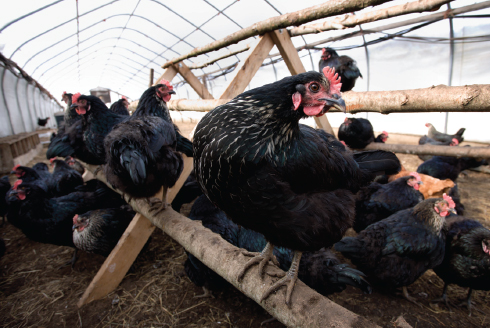
Black Star cross hens roost in an unused greenhouse at Luna Bleu Farm. While concentrated manure is composted, the chickens’ presence helps plants that are ready for harvest at least four months later.
The lining, or litter, you choose to use will play an important role in the ease of cleaning out the coop later on. While hay or straw seems like the most natural choice, it can hold moisture, become stale and moldy, and be very difficult to remove once it has become soiled. Cornhusks were historically used, but are not readily available as bedding any longer (they are now commonly ground for animal feed).
Shredded newspaper is becoming more available, but it must be changed frequently in order to keep the interior of the coop dry. Some birds are also attracted to the newsprint and may consume it rather than their feed.

Cornish Rock cross meat birds begin to wander from one of two portable coops early in the morning at Back Beyond Farm. While their manure left behind on the field improves the grass, the coop does need to be moved before too much manure accumulates and burns the pasture.
Dry softwood or pine shavings sold in bales at most feed stores are the ideal litter choice for chickens, though they are also the most expensive. The shavings do an excellent job of neutralizing the ammonia within the droppings and drying out the manure so that it is more easily handled. Shavings can also be used directly from the sawmill, but keep in mind that this litter has most likely not been kiln-dried, and will not be as good at absorbing moisture. It may also contain hardwood shavings, which tend to darken with moisture, making a less attractive interior in your coop.
A Barred Plymouth Rock cross rooster roams amongst the flower beds at Fat Rooster Farm. Its final destination was the freezer because the farm had too many roosters.